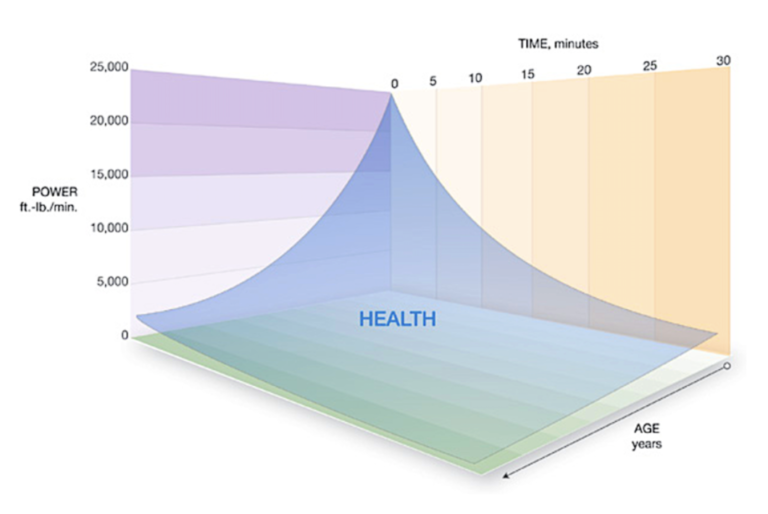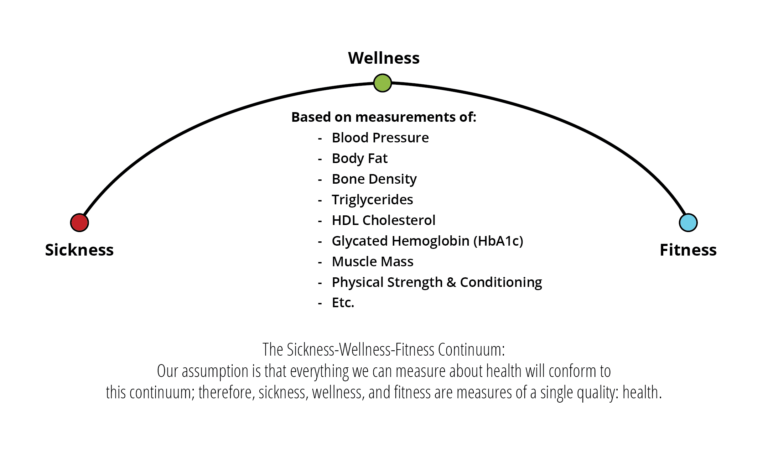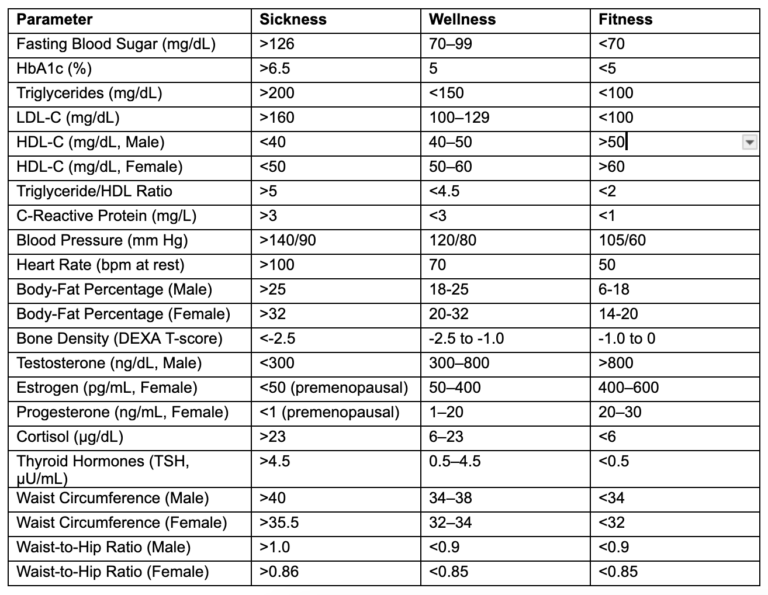CrossFit defines fitness as work capacity across broad time and modal domains. In simpler terms, your fitness is measured by how effectively you can generate power to perform a wide range of tasks involving diverse movements and combinations over different durations.
 On the other hand, health is your work capacity across broad time and, modal and age domains. It’s not just about the absence of disease or chasing performance at any cost; it’s about sustaining fitness throughout your lifetime. To enhance your health, it’s crucial to continually improve, maintain, and slow the decline of your fitness as you age. This requires adopting healthy behaviors that support performance at every stage of life, ultimately leading to better overall health markers.
On the other hand, health is your work capacity across broad time and, modal and age domains. It’s not just about the absence of disease or chasing performance at any cost; it’s about sustaining fitness throughout your lifetime. To enhance your health, it’s crucial to continually improve, maintain, and slow the decline of your fitness as you age. This requires adopting healthy behaviors that support performance at every stage of life, ultimately leading to better overall health markers.
Monitoring both performance and health markers takes time and intention; however, the payoff is worth it. It helps you accurately gauge whether your health is improving and empowers you to take control of your health and make proactive decisions to improve your well-being.
The Continuum: Sickness to Fitness
The role of exercise and nutrition in preventing sickness and improving health is undeniable. At any point in your life, your health exists on a continuum that spans from sickness to wellness to fitness.
 The sickness-wellness-fitness continuum vividly demonstrates the critical role of fitness in promoting health. On the left side of this continuum lies sickness, marked by the presence of one or more chronic diseases. In the center, we find wellness, where disease is absent and health markers are within normal ranges. At the far right, we have fitness, or super-wellness, characterized by the absence of disease and optimal health markers. Achieving super-wellness means you have a protective buffer against sickness. This physiological headroom means your health would need to decline significantly before reaching wellness, or normal, and even further before reaching sickness. Conversely, individuals with health markers centered around wellness have less room for decline before they reach the state of sickness.
The sickness-wellness-fitness continuum vividly demonstrates the critical role of fitness in promoting health. On the left side of this continuum lies sickness, marked by the presence of one or more chronic diseases. In the center, we find wellness, where disease is absent and health markers are within normal ranges. At the far right, we have fitness, or super-wellness, characterized by the absence of disease and optimal health markers. Achieving super-wellness means you have a protective buffer against sickness. This physiological headroom means your health would need to decline significantly before reaching wellness, or normal, and even further before reaching sickness. Conversely, individuals with health markers centered around wellness have less room for decline before they reach the state of sickness.
Key Health Markers
Many measurements illuminate where you lie on the sickness-wellness-fitness continuum and allow you to track progress as you move closer to fit. Though this is not an exhaustive list, these are some of the key health metrics to measure and their sickness, wellness, and fitness values (Table 1). Understanding and tracking these health markers is crucial for CrossFit athletes as they provide insights into how your body responds to the demands of CrossFit and can help you optimize your performance and health. For a more in-depth discussion on health markers, take our Nutrition I Online Course.
Fasting Blood Sugar and Glycated Hemoglobin (HbA1c)
Fasting blood sugar provides a snapshot of your blood sugar levels after not eating, while Hgb A1c offers a longer-term view of control over the past three months. Elevated levels indicate poor blood sugar management, which can lead to Type 2 diabetes, cardiovascular diseases, and other metabolic disorders. Maintaining healthy levels helps ensure your body efficiently uses glucose for energy, crucial for daily functioning and athletic performance.
Lipid Levels
Lipids, including triglycerides (TG), LDL (low-density lipoprotein), and HDL (high-density lipoprotein), are fats in your blood. The TG/HDL and HDL/LDL ratios are considered indicators of heart health. High triglycerides and low HDL levels are linked to an increased risk of heart disease. Balanced lipid levels contribute to overall cardiovascular health. LDL-C is traditionally viewed as a key marker, though it has a weaker predictive value for heart disease than HDL-C and triglycerides.
Inflammatory Markers
C-reactive protein (CRP) is a marker of inflammation in the body. Chronic inflammation is associated with a range of diseases, including heart disease, cancer, and autoimmune conditions.
Blood Pressure and Heart Rate
Blood pressure and heart rate are vital signs of cardiovascular health. High blood pressure can lead to heart disease, stroke, and kidney problems.
Body-Fat Percentage and Lean Body Mass
Body fat percentage and lean body mass are indicators of body composition. High body fat is linked to various health problems, including heart disease, Type 2 diabetes, and joint issues. Lean body mass, which includes muscles, bones, and organs, is crucial for metabolic health, physical strength, and mobility.
Bone Density
Bone density measures the strength and solidity of bones. Low bone density can lead to osteoporosis, increasing the risk of fractures and injuries.
Hormones
Hormones are crucial regulators of numerous bodily functions, including metabolism, mood, growth, and reproductive health. Key hormones to monitor include:
Testosterone: In men, testosterone levels can affect muscle mass, fat distribution, and overall vitality.
Estrogen and Progesterone: In women, these hormones play significant roles in menstrual cycles, bone density, and overall health.
Cortisol: Known as the “stress hormone,” cortisol helps regulate metabolism and immune response.
Thyroid Hormones: These hormones regulate metabolism.
Waist Circumference and Waist-to-Hip Ratio
These measurements assess the distribution of body fat. Excess abdominal fat is associated with a higher risk of metabolic diseases, such as Type 2 diabetes and cardiovascular disease.
By measuring these health markers once or twice a year, you’ll gather ample data to assess whether your training and lifestyle habits contribute positively to your health. However, if you’re actively working to improve a metric on the sick side of the continuum, you may need to measure more frequently — perhaps every quarter. Collaborating with a qualified physician or healthcare professional, especially one familiar with the benefits of CrossFit for health and performance, is not just important; it’s essential. Together, you can develop a testing schedule and monitor your progress effectively.
Table 1 Health Marker Sickness, Wellness, and Fitness Ranges

The table illustrates the various health markers categorized into “sickness,” “wellness,” and “fitness” ranges. It is important to note the values listed under “sickness” represent the thresholds beyond which health issues are more likely to occur. Those in the “wellness” range have markers indicative of normal health, while values in the “fitness” range reflect optimal health and reduce disease risk. Individuals whose markers are between “sickness” and “wellness” are closer to the sickness side of the continuum. In contrast, those with markers between “wellness” and “fitness” are closer to the fitness side. These classifications help track progress and guide lifestyle adjustments for better health outcomes.
Why Normal Doesn’t Mean Healthy
Reference ranges for health markers are established using epidemiological studies, estimating that 95% of the “healthy” population falls within these ranges. However, there has been a significant shift in population health over recent decades. For example, in the 1960s, about 13% of the population was obese. Today, that number has skyrocketed to approximately 43%. Similarly, rates of Type 2 diabetes have increased, and average testosterone levels in men have declined.
When more extensive epidemiological studies are conducted, the “normal” measurements may no longer reflect a genuinely healthy population. As our population’s health continues to decline, we might expect reference ranges to shift accordingly, potentially normalizing higher levels of sickness. This underscores the importance of striving to maintain health markers within optimal ranges. Our goal should be to move as far right on the continuum as possible rather than settling for what is statistically average but potentially indicative of poor health.
The CrossFit Medical Society provides all members the ability to measure health markers using blood panels and, as an additional service, have a CrossFit-credentialed healthcare professional provide an interpretation and recommendation. For more information, visit the CrossFit Medical Society Biomarker HUB.
Performance Markers Impact Long-Term Health
It’s important to note that health markers aren’t the only metrics that can be tracked on this continuum. Performance markers — such as deadlift weight, Fran time, mile time, back squat weight, and number of unbroken pull-ups — can also be mapped along this spectrum. For instance, if you can deadlift twice your body weight, run a mile in under 8 minutes, and perform more than 10 unbroken strict pull-ups, you are likely situated toward the fit end of the continuum. This signifies optimal physical fitness and suggests greater resilience against potential health declines.
CrossFit’s approach aims to move you further along this continuum by doing right by your body on the gym floor and in the kitchen. Our nutrition and training strategies are designed to push you as far to the right as possible — toward peak fitness and sustained health. By regularly measuring both health and performance markers, you can better understand and enhance your overall well-being and build reserves that will set you up for lasting health and vitality.
Join the CrossFit Medical Society for free at the Community Member level and keep your health markers in check.
Tell Us About Your goals!
- Which health markers are you going to prioritize over the next six months?
- What are the biggest obstacles to achieving your health goals?
About the Author
 Michael Giardina started CrossFit in 2005. He has worked as a trainer at a CrossFit affiliate and as a CrossFit Seminar Staff Flowmaster and Content Supervisor. He has competed at the CrossFit Games and served as a CrossFit Games Head Judge. He is a Certified CrossFit Coach (CF-L4), has a Master of Science in exercise physiology, a Master of Public Health, an Executive MBA, and works as CrossFit’s Senior Manager of Health Education.
Michael Giardina started CrossFit in 2005. He has worked as a trainer at a CrossFit affiliate and as a CrossFit Seminar Staff Flowmaster and Content Supervisor. He has competed at the CrossFit Games and served as a CrossFit Games Head Judge. He is a Certified CrossFit Coach (CF-L4), has a Master of Science in exercise physiology, a Master of Public Health, an Executive MBA, and works as CrossFit’s Senior Manager of Health Education.